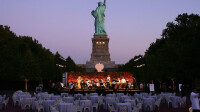Minh Hi n Tr ng Review of Statue of Liberty and Ellis Is...
The statue rapidly became a landmark. Originally, ...
The statue rapidly became a landmark. Originally, it was a dull copper color, but shortly after 1900 a green patina, also called verdigris, caused by the oxidation of the copper skin, began to spread. As early as 1902 it was mentioned in the press; by 1906 it had entirely covered the statue. Believing that the patina was evidence of corrosion, Congress authorized US$62,800 (equivalent to $1,787,000 in 2019) for various repairs, and to paint the statue both inside and out. There was considerable public protest against the proposed exterior painting. The Army Corps of Engineers studied the patina for any ill effects to the statue and concluded that it protected the skin, "softened the outlines of the Statue and made it beautiful." The statue was painted only on the inside. The Corps of Engineers also installed an elevator to take visitors from the base to the top of the pedestal.
The statue is situated in Upper New York Bay on Liberty Island south of Ellis Island, which together comprise the Statue of Liberty National Monument. Both islands were ceded by New York to the federal government in 1800. As agreed in an 1834 compact between New York and New Jersey that set the state border at the bay's midpoint, the original islands remain New York territory though located on the New Jersey side of the state line. Liberty Island is one of the islands that are part of the borough of Manhattan in New York. Land created by reclamation added to the 2.3-acre (0.93 ha) original island at Ellis Island is New Jersey territory.
No charge is made for entrance to the national monument, but there is a cost for the ferry service that all visitors must use,[180] as private boats may not dock at the island. A concession was granted in 2007 to Statue Cruises to operate the transportation and ticketing facilities, replacing Circle Line, which had operated the service since 1953. The ferries, which depart from Liberty State Park in Jersey City and the Battery in Lower Manhattan, also stop at Ellis Island when it is open to the public, making a combined trip possible. All ferry riders are subject to security screening, similar to airport procedures, prior to boarding.
Visitors intending to enter the statue's base and pedestal must obtain a complimentary museum/pedestal ticket along with their ferry ticket.Those wishing to climb the staircase within the statue to the crown purchase a special ticket, which may be reserved up to a year in advance. A total of 240 people per day are permitted to ascend: ten per group, three groups per hour. Climbers may bring only medication and cameras lockers are provided for other items and must undergo a second security screening - Wikipedia

Comments: